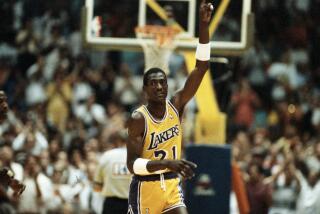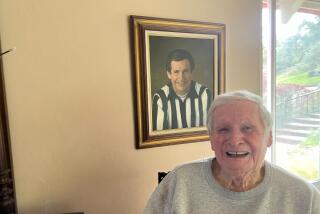R.C. Owensâ âalley-oopâ catches for 49ers were a hit right from the jump
From San Francisco â His prodigious jumping ability helped make âalley-oopâ an integral part of the sporting lexicon.
He remains, more than 40 years later, the all-time leading rebounder in the history of College of Idaho basketball.
But in R.C. Owensâ day, an alley-oop had nothing to do with a high-flying dunk off of a lob pass.
It was a football play.
Owensâ leaping end-zone catches for the San Francisco 49ers gave rise to a term that would later be co-opted by basketball.
âI donât know who came up with the name or why,â Owens says of the 49ersâ innovation of the late 1950s, âbut thatâs what we called it: the alley-oop.â
Catching otherwise out-of-reach passes from Hall of Fame quarterback Y.A. Tittle, and later from John Brodie, the 6-foot-3 Owens became so synonymous with the play that he too was christened Alley-Oop.
âThe guys would call me Oop for short,â he says.
Owens, 76, loves his nickname, which predates the chart-topping 1960 hit âAlley-Oopâ by the Hollywood Argyles but not the long-running comic strip, which inspired the song. (Alley-oop, according to meriam-webster.com, derives from the French allez-oop, the cry of a circus acrobat about to leap.)
Long a 49ers employee â Owens served as alumni and training-camp coordinator all through the teamâs Super Bowl-winning years in the 1980s and â90s â the gentlemanly grandfather is proud of his place in San Francisco and NFL lore.
The alley-oop made its debut on Oct. 6, 1957, in a game against the Los Angeles Rams at Kezar Stadium.
Owens, a rookie, caught two touchdown passes in a 23-20 49ers victory, the second by outjumping a Rams cornerback in the back corner of the end zone to provide the winning margin.
Earlier, Owens had come down with a 46-yard touchdown pass.
âTwo of the most dumbfounding, astonishing, impossible catches ever wrought on any gridiron,â Bill Leiser of the San Francisco Chronicle wrote.
What would become Owensâ signature play, it was later revealed, had developed by happy accident.
To prepare the 49ersâ secondary for the Rams and their strong-armed quarterback, Norm Van Brocklin, Coach Red Hickey had instructed his receivers to run deep pass patterns and for Tittle to throw long, high passes far down the field.
âThe coach said, âI donât care how high you throw it or how long you throw it, but run those plays and make those guys run,ââ Owens says during an interview at a San Francisco Airport hotel, where several other ex-49ers have gathered for a reunion.
It didnât take long, Owens says, before Tittle realized that many of his passes were being caught by Owens. So Tittle, showing confidence in the 14th-round draft pick, suggested to Hickey that the 49ers add the play to their own repertoire.
Mark Duncan, a 49ers assistant, told the Chronicle the play had been dubbed âalley-oopâ and said of Owens, âHe goes up in the air like a tight-coiled spring, and he holds onto the ball.â
This, Owens had been doing for years. After lettering in football and basketball at Santa Monica High, he excelled in the same sports at College of Idaho. In one season alongside Elgin Baylor, who later transferred to Seattle before being drafted by the Lakers, Owens averaged 19 points and 21 rebounds.
âThere wasnât a center that could outjump me,â he says.
Nor many cornerbacks either.
Owens caught three more alley-oop passes for touchdowns as a rookie, one for the winning points in a midseason game against Detroit and another in a playoff loss to the Lions.
Still, the 49ers were slow to renew his contract after the season, prompting Owens to join a team of NBA All-Stars for a barnstorming tour of the West Coast, where he showed enough promise that the Minneapolis Lakers offered him a contract.
That prompted the 49ers to make him a better offer, Owens says, and this time he gave up basketball for good.
In eight seasons with the 49ers, Baltimore Colts and New York Giants, he caught 206 passes, 22 for touchdowns.
And with the Colts in 1962, Owens wowed fans anew with his jumping ability, standing at the goal line and leaping to block a long, line-drive field-goal attempt by the Washington Redskins â a tactic that was soon legislated out of existence.
âEverybody went out of their minds,â he says of the reaction, âbut Iâd done it several times in practice.â
In retirement, Owens lives with wife Susan and their two dogs in Manteca, about 75 miles east of San Francisco. He says heâs in good health after a kidney transplant in 2004.
Heâs still involved with the 49ers as a consultant.
And he still answers to Alley-Oop â or Oop for short.
More to Read
Go beyond the scoreboard
Get the latest on L.A.'s teams in the daily Sports Report newsletter.
You may occasionally receive promotional content from the Los Angeles Times.










